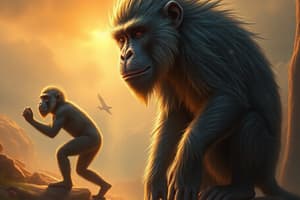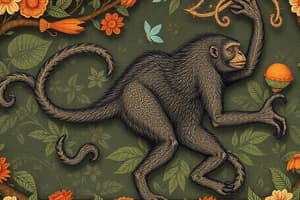Podcast
Questions and Answers
What significant change did the Neolithic agricultural revolution bring about in human societies?
What significant change did the Neolithic agricultural revolution bring about in human societies?
- Decline in technological advancements
- Increased nomadic lifestyles
- Reduction in population sizes
- Development of settled societies (correct)
Which environmental factor is NOT considered a pressure shaping human evolution?
Which environmental factor is NOT considered a pressure shaping human evolution?
- Climate change
- Technological advancements (correct)
- Food availability
- Competition with other species
How did cultural transmission affect human cognitive development?
How did cultural transmission affect human cognitive development?
- It caused a decline in social structures.
- It played a crucial role in accelerating evolution. (correct)
- It limited the abilities of early humans.
- It hindered learning and adaptation.
What correlation exists between brain size and cognitive abilities in human evolution?
What correlation exists between brain size and cognitive abilities in human evolution?
Which aspect of contemporary human biology is influenced by past human evolution?
Which aspect of contemporary human biology is influenced by past human evolution?
What key feature distinguishes primates from other mammals?
What key feature distinguishes primates from other mammals?
How did the genus Homo evolve in comparison to earlier hominins?
How did the genus Homo evolve in comparison to earlier hominins?
What significant trait is associated with Homo erectus?
What significant trait is associated with Homo erectus?
Which of the following species coexisted with Homo sapiens and likely interbred with them?
Which of the following species coexisted with Homo sapiens and likely interbred with them?
What does the fossil evidence suggest about the evolution of bipedalism?
What does the fossil evidence suggest about the evolution of bipedalism?
How did early humans disperse geographically?
How did early humans disperse geographically?
Which characteristic describes Australopithecines?
Which characteristic describes Australopithecines?
What role did adaptation play in the evolution of early human populations?
What role did adaptation play in the evolution of early human populations?
Flashcards
Primate Evolution
Primate Evolution
Primates, including humans, evolved from a common ancestor about 65-85 million years ago.
Bipedalism
Bipedalism
Walking on two legs. A key feature in human evolution.
Homo Habilis
Homo Habilis
First species in the Homo genus, associated with simple stone tools.
Homo Erectus Migration
Homo Erectus Migration
Signup and view all the flashcards
Homo Neanderthalensis
Homo Neanderthalensis
Signup and view all the flashcards
Homo Sapiens Dispersal
Homo Sapiens Dispersal
Signup and view all the flashcards
Human Evolution Adaptations
Human Evolution Adaptations
Signup and view all the flashcards
Cultural Development
Cultural Development
Signup and view all the flashcards
Human Variation
Human Variation
Signup and view all the flashcards
Neolithic Revolution
Neolithic Revolution
Signup and view all the flashcards
Environmental pressures
Environmental pressures
Signup and view all the flashcards
Natural Selection
Natural Selection
Signup and view all the flashcards
Human Evolution Applications
Human Evolution Applications
Signup and view all the flashcards
Study Notes
Human Origins and Early Evolution
- Primates, including humans, evolved from a common ancestor approximately 65-85 million years ago, diverging from other mammals.
- Early primates were small, arboreal creatures adapted to living in trees.
- Key features of primates that distinguish them from other mammals include grasping hands and feet, forward-facing eyes, and relatively large brains.
- The fossil record shows a gradual development of bipedalism(walking on two legs) and increased brain size over millions of years.
- Australopithecines, a group of hominins, are an important transitional species, showing evidence of both ape-like and human-like characteristics. Fossils like Lucy illustrate the development of bipedal locomotion.
- The genus Homo emerged later, exhibiting greater brain size and more advanced tool use.
Homo Species Evolution
- Homo habilis is considered the first species in the Homo genus and is associated with the development of simple stone tools.
- Homo erectus showed increased brain size, sophisticated tool use, and the first evidence of fire use. Key to their development was migration out of Africa, spreading to other parts of the world.
- Homo neanderthalensis, while a separate species, coexisted and likely interbred with Homo sapiens, sharing genetic material with modern humans.
- Homo floresiensis is an example of a hominin species whose smaller size, compared to other humans, challenged our understanding of human evolution.
Homo Sapiens Emergence and Dispersal
- Homo sapiens, modern humans, evolved in Africa and gradually dispersed across the globe over a long period.
- Migration patterns show early humans populating various areas, including Asia, Europe, and eventually the Americas.
- The timing and routes of migrations are still actively researched, with new discoveries constantly refining our understanding.
- Population genetics data indicates that a group of humans left Africa and diversified into various populations. There's debate about the specific number of migrations and the extent to which different groups interbred.
Late Human Evolution/Development
- As populations spread across the globe, adaptation and diversification in local environments played a role in their evolution.
- Cultural and technological developments, such as the development of art, complex social structures and agriculture, occurred over millennia.
- Human populations encountered different environmental conditions, leading to variation in physical characteristics.
- The Neolithic agricultural revolution marked a critical turning point, leading to settled societies, leading to further technological development and population growth
The Role of Environment and Adaptation
- Environmental pressures, including climate change, food availability, and competition with other species, greatly shaped human evolution.
- Natural selection favoured traits that enhanced survival and reproduction in specific environments.
Cognitive and Cultural Development
- Increased brain size is correlated with developing sophisticated cognitive abilities like abstract thought, planning, and complex language.
- Advances in tool use, art, and social structures are significant markers of human cognitive development.
- Cultural transmission of knowledge played a crucial role in accelerating human evolution. Learning and adapting in societies has been critical
Contemporary Issues related to Human Evolution
- Understanding human evolution has many applications for understanding present-day health problems. Researchers look at genetic diseases and susceptibility.
- Contemporary human biology is impacted by the past, as genetic adaptations to specific environments persist in modern populations. This influences how people react to disease and environmental stressors.
- The study of human evolution is central to answering questions about our origins and future. It touches on deep concerns about population health and interactions with the environment.
Studying That Suits You
Use AI to generate personalized quizzes and flashcards to suit your learning preferences.




